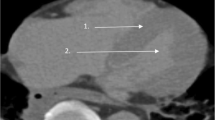Abstract
Epicardial adipose tissue (EAT) may play a role in the development of coronary artery disease. The purpose of this study was to evaluate a method based on postmortem computed tomography (PMCT) for the estimation of EAT volume. We PMCT-scanned the eviscerated hearts of 144 deceased individuals, who underwent a medicolegal autopsy. Using Mimics® we performed segmentation of the images and obtained the volumes of EAT and myocardium. Total heart volume was calculated by adding the volumes of EAT and myocardium. Total heart weight, including EAT, myocardium and attached vessels, was measured during autopsy. Inter-observer analysis was performed on 30 randomly chosen subjects. We included 132 individuals in the results (age range: 22–94 years; 56% men). Twelve individuals were excluded due to inadequate PMCT scanning. Median EAT volume was 73.0 mL (Interquartile range; IQR: 45.6–113.7 mL) in men and 64.8 mL (IQR: 44.0–98.0 mL) in women, which accounted for 20.4 ± 10.2% and 21.9 ± 9.5% of total heart volume, respectively. This corresponded with former autopsy studies. Total heart volume measured by PMCT was highly correlated with heart weight (R2 = 90%). Mean inter-observer difference of EAT volume was −1.7 mL (95% limits of agreement: −37.0-33.6 mL), with an Intra Class Correlation of 0.91. It was possible to estimate EAT volume using PMCT on eviscerated human hearts. Our method was fast and accurate with good inter-observer agreement. This is a useful method to determine EAT at autopsy, and we will apply this method in future research.




Similar content being viewed by others
References
Alexopoulos N, McLean DS, Janik M, Arepalli CD, Stillman AE, Raggi P. Epicardial adipose tissue and coronary artery plaque characteristics. Atherosclerosis. 2010;210:150–4.
Yerramasu A, Dey D, Venuraju S, Anand DV, Atwal S, Corder R, et al. Increased volume of epicardial fat is an independent risk factor for accelerated progression of sub-clinical coronary atherosclerosis. Atherosclerosis. 2012;220:223–30.
Ding J, Hsu FC, Harris TB, Liu Y, Kritchevsky SB, Szklo M, et al. The association of pericardial fat with incident coronary heart disease: the Multi-Ethnic Study of Atherosclerosis (MESA). Am J Clin Nutr. 2009;90:499–504.
Mahabadi AA, Berg MH, Lehmann N, Kälsch H, Bauer M, Kara K, et al. Association of epicardial fat with cardiovascular risk factors and incident myocardial infarction in the general population. J Am Coll Cardiol. 2013;61:1388–95.
Choi TY, Ahmadi N, Sourayanezhad S, Zeb I, Budoff MJ. Relation of vascular stiffness with epicardial and pericardial adipose tissues, and coronary atherosclerosis. Atherosclerosis. 2013;229:118–23.
Rabkin SW. Epicardial fat: properties, function and relationship to obesity. Obes Rev. 2007;8:253–61.
Jakobsen LS, Lundemose S, Banner J, Lynnerup N, Jacobsen C. Forensic postmortem computed tomography: volumetric measurement of the heart and liver. Forensic Sci Med Pathol. 2016;12:510–6.
Bland JM, Altman D. Statistical methods for assessing agreement between two methods of clinical measurement. Lancet. 1986;327:307–10.
Du Bois D, Du Bois EF. A formula to estimate the approximate surface area if height and weight be known. Arch Intern Med. 1916;17:863–71.
Marchington JM, Mattacks CA, Pond CM. Adipose tissue in the mammalian heart and pericardium: structure, foetal development and biochemical properties. Comp Biochem Physiol B. 1989;94:225–32.
Nelson AJ, Worthley MI, Psaltis PJ, Carbone A, Dundon BK, Duncan RF, et al. Validation of cardiovascular magnetic resonance assessment of pericardial adipose tissue volume. J Cardiovasc Magn Reson. 2009;11:15.
Sons HU, Hoffmann V. Epicardial fat cell size, fat distribution and fat infiltration of the right and left ventricle of the heart. Anat Anz. 1986;161:355–73.
Shirani J, Berezowski K, Roberts WC. Quantitative measurement of normal and excessive (cor adiposum) subepicardial adipose tissue, its clinical significance, and its effect on electrocardiographic PRS voltage. Am J Cardiol. 2017;76:414–8.
Reiner L, Mazzoleni A, Rodriguez FL. Statistical analysis of the epicardial fat weight in human hearts. AMA Arch Pathol. 1955;60:369–73.
Acknowledgements
The authors thank the autopsy technicians who assisted at autopsy and CT-scan and the team behind the SURVIVE study.
Funding
No funding.
Author information
Authors and Affiliations
Corresponding author
Ethics declarations
Conflicts of interest
The authors declare that they have no conflict of interest.
Rights and permissions
About this article
Cite this article
Hindsø, L., Jakobsen, L.S., Jacobsen, C. et al. Epicardial adipose tissue volume estimation by postmortem computed tomography of eviscerated hearts. Forensic Sci Med Pathol 13, 468–472 (2017). https://doi.org/10.1007/s12024-017-9930-1
Accepted:
Published:
Issue Date:
DOI: https://doi.org/10.1007/s12024-017-9930-1




